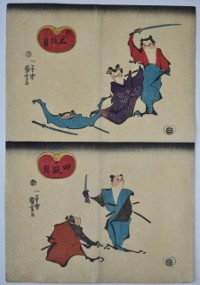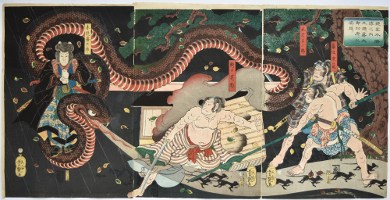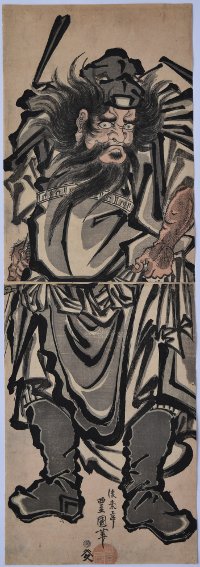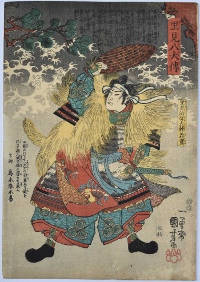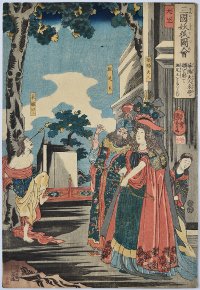/category/warriors-and-legends/page/5/
Tsukioka YOSHITOSHI (1839-1892)

Click here to view image full size.
A chuban print from a set Wakan goki zoroi, “Valour in China and Japan.” Shows Kintaro about to deliver a blow to the Thunder God Raijin (the God of thunder and lightning – a Japanese Thor). Published by Daisada, 1868. A rare set.
Fine impression, colour and condition. Signed Ikkaisai Yoshitoshi hitsu.
Status: Sold
Utagawa KUNIYOSHI (1797-1861)

Click here to view image full size.
Wada Heita Tanenaga (1182-1213), short sword in hand, struggling with a giant python. He was a renowned archer and retainer of Minamoto no Yoriie. Various stories tell of how he came across the python in a cave or saved a village from its carnivorous attacks. From an untitled early set published by Yamashiroya Heisuke, c. 1845. Robinson S1f.8. A striking design and rare.
Very good impression and colour. Slight trimming, otherwise very good condition. Signed Ichiyusai Kuniyoshi ga.
Status: Sold
Utagawa KUNIYOSHI (1797-1861)
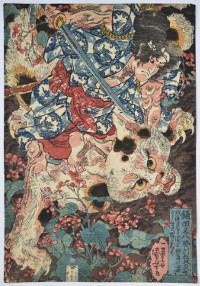
Click here to view image full size.
Kamada Matahachi of Matsusaka in Ise Province killing a monstrous cat. These mountain cats – nekomata – were reputed to eat humans. Published by Tsutaya Kichizo, c. 1840. Robinson S1e.3. A wonderful and rare design.
Very good impression and colour. Repair bottom right corner and slight trimming, otherwise good condition. Signed Ichiyusai Kuniyoshi ga.
Status: Sold
Utagawa KUNIYOSHI (1797-1861)
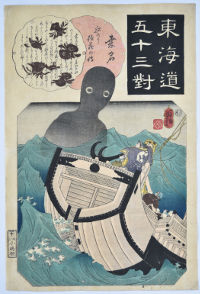
Click here to view image full size.
The apparition of the Sea Monk, Umibozu, looming above the sailor Kawanaya Tokuzo. The best design from Tokaido gojusan tsui, Station 41, Kuwana. The legend has it that Tokuzo, against the advice of his peers, went to sea on the last day of the year. He subsequently experienced huge seas and the monster who demanded to know what was the most horrible thing he knew. He replied that his profession was the most horrid. Satisfied, the creature descended into the Stygian gloom and the storm abated. Published by Kojimaya Jubei, c. 1845. Illustrated in Robinson, Kuniyoshi, HMSO, 1961, no. 49.
Fine early impression with the light blue on the sea. Very good colour and condition. Signed Ichiyusai Kuniyoshi ga.
Status: Sold
Utagawa KUNISADA (1786-1864)

Click here to view image full size.
A vertical diptych showing the famous waka poet Ono no Komachi (c. 1825-c. 900) being sheltered by attendants from an upcoming storm. She is famous for composing a poem and praying for rain at the behest of the Emperor Junna during a period of drought across Japan. The poem she composed, shown above, she threw into the pond of the Shinsen-en Garden. It started raining after three days . The poem reads: Though it is called the “land beneath the sun [Japan]” surely it must rain here. Published by Kikakudo, c. 1833-35. Rare.
Fine impression, colour and condition. Signed Kochoro Kunisada ga.
Status: Sold
Utagawa KUNIYOSHI (1797-1861)

Click here to view image full size.
A triptych showing Miyamoto Mushashi (c. 1584-1645) fighting a pack of wolves in the mountains of Hakone watched by Sekiguchi Yataro seated beside a fire. Musashi was a renowned double-bladed swordsman (as seen here) and is considered the sword-saint of Japan. Published by Kiya Sojiro, 4/1861 and is probably Kuniyoshi’s last print.
Very good impression and colour. Slight creasing, otherwise very good condition. Signed Ichiyusai Kuniyoshi ga.
Status: Sold
Tsukioka YOSHITOSHI (1839-1892)
Click here to view image full size.
Click here to view image full size.
A complete hexaptych (six-sheet) design comprising two triptychs: Kawanakajima okassen no zu, “The Great Battle of Kawanakajima,” published by Tsujibun, 6/1866 and Takeda yusho kessen no zu, “The Bloody Battle of the Brave Generals of the Takeda Clan,” published by Tsujibun, 6/1867. The great battles of Kawanakajima took place between 1553 and 1564 between the daimyos Takeda Shingen (1521-1573) and Uesugi Kenshin (1530-1578). Starting as more skirmishes than all out warfare they ended up with a fourth battle where Kenshin is estimated to have had 72% casualties and Shingen 62%. Rare complete.
Fine impression, colour and condition. Signed Ikkaisai Yoshitoshi hitsu.
Status: Sold
Utagawa KUNISADA (1786-1864)
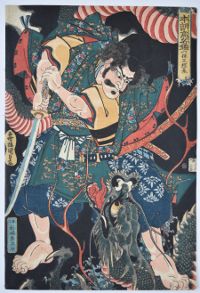
Click here to view image full size.
An early warrior print showing Rokuson Okeigi (Minamoto no Tsunemoto [894-961]) battling a giant dragon. From a set Honcho komei kagami, “A Mirror of Our Country’s Renown Heroes” published by Joshuya Kinzo, c. 1835.
Fine impression and colour. Slight trimming, otherwise very good condition. Signed Kocho Kunisada ga.
Status: Sold
Utagawa KUNIYOSHI (1797-1861)
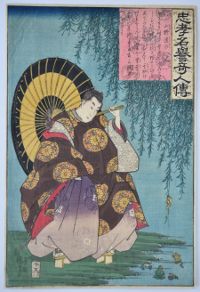
Click here to view image full size.
Ono no Tofu (Michikaze) in court robes learns perserverance by watching the efforts of a frog to climb a branch of a willow tree. From a set Chuko meiyo kijin den, “Stories of Remarkable Persons of Loyalty and High Reputation.” Published c. 1845 by Enshuya Matabei. Robinson S35.10.
Fine impression and colour. Very good condition. Signed Ichiyusai Kuniyoshi ga.
Status: Sold
Utagawa KUNIYOSHI (1797-1861)
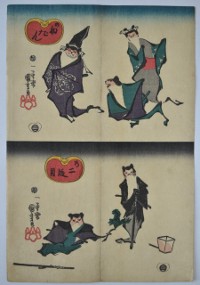
Click here to view image full size.
Six uncut double chuban sheets from a bat Chushingura set. Acts 1 to 6: Shodanme; Nidanme; Sandanme; Yodanme; Godanme; Rokudanme. Published c. 1847 by Ibaya Senzaburo. Of the utmost rarity: I cannot, at the moment, locate other examples from this set.
Fine impressions and colour. Vertical centre folds, otherwise fine condition. Signed Ichiyusai Kuniyoshi ga on each sheet.
Status: Sold
Taiso YOSHITOSHI (1839-1892)

Click here to view image full size.
A design from a set Azuma nishiki ukiyo kodan, “Rough Tales of the Floating World.” Various publishers between 1867 -1868, here Omi-Kyu in 1868. The prints interpret stories told by various well known storytellers, in this case Momokawa Enkoku. Shows the Monkey King (Son Goku) being catapulted into the air by the force of the large palm fan of Princess Iron Fan. (The fan was capable of creating strong winds and putting out fires.) She was a Rasetsunyo, a female protector of Buddhism. A comparatively rare set.
Very good impression, colour and condition. Signed Ikkaisai Yoshitoshi hitsu.
Status: Sold
Taiso YOSHITOSHI (1839-1892)

Click here to view image full size.
Shows the famous Heron Maiden. There are different versions of this story but the most common tells how a young man finds an injured heron. He nurses it back to health and releases it. Some time later a beautiful young woman appears in his village. He falls in love and they marry. She makes fine brocade which they sell, but she does not allow him to see her making it. Tempted he secretly views her only to discover she is the heron. This is the end of their marriage and the heron flies away. From a set Shingata sanjurokkaisen, “New Forms of Thirty-six Ghosts,” sub-title: Sagi musume. The set published by Sasaki between 1889- 1892 (this being 1889). This is the first edition.
Very fine impression, colour and condition. Signed Yoshitoshi.
Status: Sold
Taiso YOSHITOSHI (1839-1892)

Click here to view image full size.
A triptych Masakiyo sankan taiji no zu, “A Picture of Masakiyo Conquering Korea.” The design purports to show Kato Kiyomasa (1562-1611) invading Korea, but is probably a reference to the English bombardment of Kagoshima harbour in 1863. There is further confusion by the Koreans being dressed in medieval European costumes. Published by Yamaguchiya in 1864. There is a history in ukiyo-e of commenting on current – but sensitive – events, but setting them in the distant past to avoid censorship.
Fine early impression with burnishing on boat. Fine colour. Slight creases along right edge of sheets, otherwise very good condition. Signed Ikkaisai Yoshitoshi ga.
Status: Sold
Utagawa YOSHICHIKA (Fl. c. 1850-1868)

Click here to view image full size.
A triptych showing the famous battle at Honno-ji Temple, Nakagyo-ku, Kyoto in 1582. Honno-ji dai gassen no zu. The Daimyo Oda Nobunaga was at the height of his powers but came under attack from his treacherous samurai general Akechi Mitsuhide and the Oda forces. Nobunaga, his wife Noh and his retainers battle valiantly but he is forced to commit suicide. Published by Fujiokaya Keijiro, 1861.
Very fine impression, colour and condition. Signed Ikkesisai Yoshichika ga.
Status: Sold
Utagawa KUNIYOSHI (1797-1861)
Click here to view image full size.
A triptych showing Kato Kiyomasa (Watonai) attacking a huge man-eating tiger in a snowy Korean landscape. Watonai tora-gari no zu. His henchmen tackle other tigers. This is one of his best known exploits in Korea, there being two expeditions in 1592 and 1597. Published by Yamashiroya Jimbei, c 1846. Robinson T183. A fine and rare design.
Fine impression, colour and condition. Full size. Signed Ichiyusai Kuniyoshi ga.
Status: Sold
Utagawa YOSHITORA (Active 1836-87)
Click here to view image full size.
Uji Joetsu killing a huge monster with a long-haired albino coat and giant claws. From a set: Honcho kendo tatsujin hyakunin no uchi hitori, “A Hundred Great Swordsmen of Our Country.” Published by Itoya Fukujiro, 1859.
Fine impression. The monster’s coat completely blind-printed. Fine colour. Slightly trimmed, otherwise very good condition. Signed Yoshitora ga.
Status: Sold
Utagawa KUNIYOSHI (1797-1861)
Click here to view image full size.
The priest Nichiren standing on the rocky promontory at Reizan in Kamakura and having his prayers for rain answered. The event occurred in 1271. His disciples surround him and protect him from the deluge with a large umbrella. Bunei hachi Kamakura Reizan-ga-saki uki. The second best design from Koso [ Nichiren ] goichidai ryakuzu, “Illustrated Abridged Biography of the Founder.” Nichiren ( 1222 – 1282 ) was the founder of the Buddhist Nichiren sect ( Nichiren shu – Kuniyoshi being a follower ) and indeed the set of ten prints may have been commissioned to mark the 550th anniversary of his death. Published by Iseya Rihei c 1831.
Fine impression and colour. Small repaired binding holes in right margin, otherwise fine condition. Full size with ample room on top border for the umbrella which protrudes beyond the border and is notorious for being trimmed. Signed Ichiyusai Kuniyoshi ga.
Status: Sold
Taiso YOSHITOSHI (1839-1892)
Click here to view image full size.
Roba kiwan o mochisaru from Shingata sanjurokkaisen, “New Forms of Thirty-Six Ghosts.” The set of thirty-six prints published by Sasaki Toyokichi 1889-1892 (this being 1889). Shows the demon Ibaraki escaping with her severed arm. She had haunted the Rashomon Gate near the Toji Temple in Kyoto. Watanabe no Tsuna is commanded to kill her but only succeeds in cutting an arm off. Knowing she will return he locks it in a box. Subsequently his elderly aunt visits him and asks to see it, whereupon she reverts to her demonic self and seizes the limb. In another version she haunts the Modori bridge, Ichijo, in Kyoto.
Very fine impression of the first edition with burnishing. Fine colour. Very slight crease, otherwise fine condition. Signed Yoshitoshi.
Status: Sold
Utagawa KUNIYOSHI (1797-1861)
Click here to view image full size.
Hashihime from Buyu nazoraye Genji, “Heroic Comparisons for the Chapters of Genji.” Shows Watanabe no Tsuna on horseback and the demon-woman Ibaraki at the Modori bridge, Ichijo, Kyoto. An o-tanzaku set published by Iba-ya Sensaburo, c 1843. The fifty-four Chapters of Genji, the Genji Monogatari, was a tenth century romance by Murasaki-Shikibu. In this version of the story Watanabe is enchanted by a beautiful young woman, but his suspicions are aroused and then confirmed when he sees her reflection in the river which reveals her true demonic self. The outcome of this version is the same with Ibaraki’s arm being cut off.
Very fine impression, colour and condition. Signed Ichiyusai Kuniyoshi ga.
Status: Sold
Taiso YOSHITOSHI (1839-1892)
Click here to view image full size.
Komachizakura no sei from Shingata sanjurokkaisen, “New Forms of Thirty-Six Ghosts.” The set of thirty-six prints published by Sasaki Toyokichi 1889-1892 (this being 1889). The story relates how Lord Kuronushi is on his way to attempt the overthrow of the Emperor. To make his journey auspicious he stops to build a shrine using an ancient cherry tree. The spirit of the cherry tree appears in the form of Kurozume – a courtesan with magical powers. She extracts the details of the plot and punishes him.
Very fine impression of the first edition with burnishing. Fine colour. Very slight crease, otherwise fine condition. Signed Yoshitoshi.
Status: Sold
Ichieisai YOSHITSUYA (1822-1866)
Click here to view image full size.
A dramatic triptych: Kyokyaku Suikoden no uchi: Kogakure no Kiritaro yojutsu o motte sugata o kakasu. The Kyokyaku Suikoden: Kogakure no Kiritaro hiding himself by using witchcraft. The snake, with Kiritaro standing on him, has emanated from the kago in the centre sheet to the confusion of the three attackers: Waniguchi Jinsuke (centre) and Masakino Torazo and Kazama Hanjiro. A stream of rats is emitted from the snake’s mouth. I have not been able to source this story. Published by Kameya Iwakuchi, 1861. Rare.
Fine impression. Very good colour. Sumi marks au verso showing through slightly, otherwise very good condition. Signed Ichieisai Yoshitsuya ga.
Status: Sold
Utagawa KUNIYOSHI (1797-1861)
Click here to view image full size.
Tametomo at the age of thirteen catching the arrows shot at him by two of the Emperor’s guard in a competition with Shonagon Nyudo Shinsei. From a set: Tametomo homare no jikketsu, “Ten Famous Excellencies of Tametomo.” The set published by Aritaya Seiyemon, c 1848-51.
Extremely fine impression, colour and condition. Signed Ichiyusai Kuniyoshi ga.
Status: Sold
Utagawa KUNIYOSHI (1797-1861)
Click here to view image full size.
Takeda Shingen seated and holding a war-fan and rosary and fully armoured. From a series: Meiko hyaku yu den, “Stories of a Hundred Heroes of High Renown” published by Idzumiya Ichibei, 1843-4.
Very fine impression, fine colour and condition. Signed Ichiyusai Kuniyoshi ga.
Status: Sold
Toyohara KUNICHIKA (1835-1900)
Click here to view image full size.
The devoted wife Sayohime from Thirty-six Good and Evil Beauties.” She is seen on a rocky outcrop watching her husband Otomo Sadehiko sail away to war. Legend has it that she wept for so long that she eventually turned to stone. The figure being referred to as Bofu-seki, “Weeping-wife Stone.” Published by Fukuda Kumajiro, 1876.
Very fine impression of the first edition . Small backed wormhole top margin and small thinned area, otherwise fine condition. Signed Yasohachi Kunichika hitsu.
Status: Sold
Utagawa TOYOKUNI II (TOYOSHIGE) (1777-1835)
Click here to view image full size.
A vertical diptych of Shoki, the Demon Queller. The character originates from China being a deity from China’s Taoist pantheon. He is always shown with his scholar’s hat, large robe and boots, and usually carrying a sword with which he attacks oni. Images of Shoki were hung outside houses to ward off evil during the Boys’ Day Festival on May 5th. Published by Yamamoto Kyubei, c 1820. Prints by Toyoshige are often misattributed to Toyokuni I and vice versa because late Toyokuni I signatures and those of Toyoshige are similar. Rare.
Very good impression and colour. Some edge soil, otherwise very good condition. Signed Gosotei Toyokuni hitsu.
Status: Sold
Taiso YOSHITOSHI (1839-1892)
Click here to view image full size.
A vertical diptych: Mongaku shonin aragyo no zu. One of a series of 16 vertical diptychs published in the 1880s. Shows the priest Mongaku atoning for his sins in the icy waters of the Nachi waterfall but being saved just in time by Seitaka doji, one of the two main boy servants of the Buddhist guardian deity Fudo-myoo (shown above). Published by Matsui Eikichi, 1885.
Very fine impression. Fine colour. The first edition with the title printed in red at the bottom. On thick deluxe hosho. Slight bleeding of the red seal, otherwise fine condition with the extra paper at left and top. Signed Oju Yoshitoshi ga.
Status: Sold
Utagawa KUNIYOSHI (1797-1861)
Click here to view image full size.
Minamoto Tametomo (1139-70) decapitating Yamaotoko from a set of ten prints: Tametomo homare no jikketsu, “Ten Famous Glories of Tametomo.” A great archer (it being said that his left arm was four inches longer than his right), and a wild and colourful character. The story shown here relates how Tametomo, while exiled to the island of Izu Oshima, discovers a nearby island inhabited by creatures with a demon-like countenance, red faces and long red hair hanging over their foreheads. He eventually subjugates the devils and is regarded as a king by the islanders. Published by Aritaya Seiemon, 1847-50.
Fine impression, colour and condition. Signed Ichiyusai Kuniyoshi ga.
Status: Sold
Utagawa KUNIYOSHI (1798-1861)
Click here to view image full size.
Satomi Jibu-no-taifu Yoshizane, a daimyo in control of Takita Castle from Satomi Hakkenden, the eight heroes of Bakin’s novel Hakkenden. Published by Mikawa-ya Tetsugoro, c 1849-51. See the Kunichika triptych of the same subject on this current selection.
Very good impression, colour and condition. Signed Ichiryusai Kuniyoshi ga.
Status: Sold
Utagawa KUNIYOSHI (1798-1861)
Click here to view image full size.
Nitta Tadatsune encountering the goddess of Mount Fuji and her dragon in a cavern with numerous stalactites and a fast flowing river and waterfall. She complimented Tadatsune on his courage while his compatriots were stricken with terror. Statues of the goddess Kwannon ( Chin: Guanyin ) are often found in caves. Published by Tsuji-ya Yasubei, c. 1844. Robinson T143. A fine design.
Very good impression, colour and condition. Signed Ichiyusai Kuniyoshi ga.
Status: Sold
Utagawa KUNIYOSHI (1797-1861)
Click here to view image full size.
Araki Matayemon standing, examining his sword from Honcho kendo ryaku den, “Abridged Stories of Our Country’s Swordsmanship.” The set published by Kadzusaya Iwazo in c 1845-6.
Extremely fine impression, colour and condition. Solid yellow ground. Signed Ichiyusai Kuniyoshi ga.
Status: Sold
Utagawa KUNIYOSHI (1797-1861)
Click here to view image full size.
Yoshioka Kanefusa defending himself in an attack by police from Honcho kendo ryaku den, “Abridged Stories of Our Country’s Swordsmanship.” The set published by Kadzusaya Iwazo in c 1845-6.
Extremely fine impression, colour and condition. Solid yellow ground. Signed Ichiyusai Kuniyoshi ga.
Status: Sold
Utagawa KUNIYOSHI (1797-1861)
Click here to view image full size.
A bust portrait of Goshaku Somegoro playing a shakuhachi from the series Kuniyoshi moyo shofuda tsuketari genkin otoko, “ Men of Ready Money with True Labels Attached, Kuniyoshi Fashion.” The title derived from a contemporary kabuki play Shofuda tsuki kongen kusazuri. Poem above by Umeya. Robinson S40.3. Published by Ibaya Kyubei, 1845.
Fine impression and colour. Slight trimming and retains original album backing, otherwise fine condition. Signed Ichiyusai Kuniyoshi ga.
Status: Sold
Utagawa KUNIYOSHI (1797-1861)
Click here to view image full size.
A bust portrait of the sumo wrestler Nuregami Chogoro holding a pipe from the series Kuniyoshi moyo shofuda tsuketari genkin otoko, “ Men of Ready Money with True Labels Attached, Kuniyoshi Fashion.” The title derived from a contemporary kabuki play Shofuda tsuki kongen kusazuri. Poem above by Rosho. Robinson S40.5. Published by Ibaya Kyubei, 1845.
Fine impression and colour. Slight trimming and retains original album backing, otherwise fine condition. Signed Ichiyusai Kuniyoshi ga.
Status: Sold
Ichieisai YOSHITSUYA (1822-1866)
Click here to view image full size.
Yoshida Sadaemon Kanesada slicing arrows in half with his sword from a set Gishi Meimei jitsu den, “Biographies of Loyal Followers [aka The 47 Ronin].” The series published by Tsujiokaya Bunsuke, 1860.
Extremely fine impression, colour and condition. Signed Ichieisai Yoshitsuya ga.
Status: Sold
Utagawa KUNIYOSHI (1797-1861)
Click here to view image full size.
Sasaki Ganryu standing, in profile, with clenched fist, from Honcho kendo ryaku den, “Abridged Stories of Our Country’s Swordsmanship.” The set published by Kadzusaya Iwazo in c 1845-6.
Extremely fine impression, colour and condition. Solid yellow ground. Signed Ichiyusai Kuniyoshi ga.
Status: Sold
Utagawa KUNIYOSHI (1798 – 1861)
Click here to view image full size.
Tadatsune killing the monstrous wild boar watched by Yoritomo and his entourage. Published c 1842-3. Robinson T99.
Fine impression and colour. Minor trimming, otherwise very good condition. Signed Ichiyusai Kuniyoshi ga.
Status: Sold
Taiso YOSHITOSHI (1839-1892)
Click here to view image full size.
Kiyohime assumes a serpent form at Hidaka river as she continues her pursuit of the monk Anchin. From the set Shinkei sanjurokkaisen, “New Forms of Thirty-Six Ghosts.” The set published by Sasaki Toyokichi, 1889 and 1890.
Extremely fine impression of the first edition with three-colour cartouche. Fine colour and condition. Signed Yoshitoshi.
Status: Sold
Taiso YOSHITOSHI (1839-1892)
Click here to view image full size.
A design showing Hojo Tokiyori in a snowy landscape from the set Dai Nippon meisho kagami, “Mirror of Famous Commanders of Great Japan.” He was Regent during the Kamakura period (1185-1333) but withdrew to the temple of Saimyoji and subsequently travelled around the country incognito to familiarize himself with the conditions of the populace. Published by Funazu Chujiro, 1878.
Fine impression with extensive burnishing. Fine colour. Light backing, otherwise very good condition. Signed Oju Yoshitoshi hitsu.
Status: Sold
Taiso YOSHITOSHI (1839-1892)
Click here to view image full size.
Takeda Katsuchiyo in his boyhood killing an old badger which had transformed itself into a wooden saddle-horse. From the set Shinkei sanjurokkaisen, “New Forms of Thirty-Six Ghosts.” The set published by Sasaki Toyokichi, 1889 and 1890.
Very fine impression of the first edition with three-colour cartouche. Fine colour. Very good condition. Signed Yoshitoshi.
Status: Sold
Utagawa KUNIYOSHI (1797-1861)
Click here to view image full size.
India from Sangoku yoko zue, “The Magic Fox of the Three Countries [China, India, Japan].” A set with strong western elements. Here showing Kwayo-fujin (the fox) having shot a St. Sebastian-like figure in the eye watched by King Hansoku. Both attired in exotic and archaic western garments and head pieces. Also western influences in the sky, trees and architecture. The set published by Iseya Chusuke and Echizenya Hachiyemon, c 1849-50. Unidentified collector’s seal bottom left. Rare.
Fine impression with strong woodgrain. Very good colour and condition. Signed Ichiyusai Kuniyoshi ga.
Status: Sold


